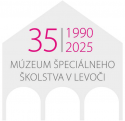Institution for Provision for and Employment for the Adult Blind in Bohemia, 1832
The first Prague Institute was established through a strange coincidence of circumstances. At that time, there was a collection declared in Prague and which revenue should be used for the construction of a second bridge over the Vltava river. The Construction project, unfortunately, mysteriously failed and all the finance have been moved to establish the Hradčany Institute. The initiative to establish such institute was made by Josef Máder who lost his sight in adulthood. His proposal was approved and supported by Count Wallis, then ambassador of the Czech Republic in Paris having knowledge of the functioning institute for the blind in Paris. Alois Klar, a member of the Presidency, was involved in the development of the first statutes of the institute. Prokop von Platzer became the first director of the institute. Klar, however, suggested an establishment which could be a sort of continuation of Hradčany Institute in the sense of “employing and supporting” facility. In 1831 he outlined the comprehensive vision of the institute for the blind and received major support from the Empress Carolina Augusta who supported the establishment of the institute by the first financial investment. Klar demonstrated his proposals through the real results of similar facility, the Vienna private association of supporting and employing institute for blind adults which was functioning since 1829. In 1831, the 68-year-old Klar gave up teaching activity and resigned as a university professor, to which he was more or less forced because of his dilapidated health. In May 1832, Klar decided resolutely and rented a building on the Veľkoprievozske Square in Prague. The trial employment for the blind became the knitting and spinning of the flax. The Presidium approved 4 October 1832 as the opening day of the Institution for Provision for and Employment for the Adult Blind in Bohemia.
Alois Klar died in March 1833.
His sole son Pavel Alois became the follower of his work.
He inherited the leased building on Veľkoprievozske Square together with 5 blind people. At that time the functioning of the Institute depended on 17 contributing members and the preliminary capital was 12,600 florins. This was solved by the Emperor Francis I, who during a personal visit in the institute promised to help. He appreciated Klar’s tenacity and hard work for the benefit of the blind and gave him a land between Daliborka Tower and Old Castle Steps. On this land there was later built a new building of the Klar Institute in Mala Strana, today’s Klarov (metro stop – Malostranská).
During the years 1836-1863 all new funding was consumed by the Klarov site, which envisaged the number of the blind to 300 including staff. The construction of the building in Klarov (in which currently houses the Czech Geological Library) began in 1836 and it served the blind to the mid-20th century, when they moved into the new building in Prague Krc, where it still functions as a follower of the historical Klar Institute – High and Kindergarten school of Alois Klar.
Since 1860 the institute was directed by the Pavol Alois’ youngest son – Rudolf Maria Klar.
At this time there was 60 blind people living who were dealing mostly with the manual work. After 17 years of Rudolf M. Klar’s direction their number increased to 112. Most of them worked in workshops and learned various crafts. Rudolf M. Klar was creative and practical expert. The establishment of the kindergarten belongs among his brilliant ideas.
Rudolf Maria Klar died of kidney inflammation on 3rd of October 1898.


